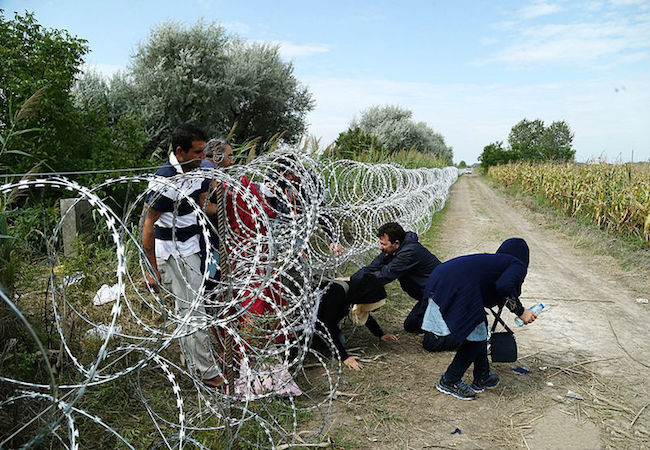
By Florian Bieber
The term “Balkans route” and images of thousands of refugees crossing Greece, Macedonia, Serbia, and Croatia brought the Balkans back onto Europe’s headlines and into its policy considerations. The hundreds of thousands of people crossing the region stretched governments and their support services to maximum capacity. For fear of being “stuck” with unwanted and unwilling refugees, long-term planning was kept to a minimum with most governments acting as second-rate travel agencies, shipping refugees from their borders in the east or south to the north and west (or having private companies profit from charging refugees for the ride). A groundswell of civic initiatives compensated for government neglect. Every signal from Germany was nervously observed as affected countries contemplated whether opening or closing their borders should be the next step. In the end, the flow of refugees acted to spur the generation of bad blood among neighbors, while otherwise having a limited impact. The only elections to take place in the Balkans during the height of the refugee flow occurred in Croatia, and here the nationalist opposition, which openly called for the closure of Croatia’s borders, failed to benefit from the “crisis”.
Still, the refugee “crisis” has left its traces in the Balkan region. It highlighted a region without European leadership and without the EU as an important actor. When governments met to manage the refugee flow, they included EU and non-EU countries. The conflicts between countries involved both those that were EU and non-EU members, and there was little in the way of telling the difference. Hungary set up barbed wire fences not just on its border with non-EU Serbia but also with EU Croatia, and Slovenia equally reinforced its border with Croatia. The weakness of the EU in this instance sends a worrying signal to the region, whose main engine for reform has been the promise—however remote—of EU integration.
The impact of the war in Syria and the rise of ISIS in the Middle East has been the growth of terrorism in Europe. In Western Europe, this has led to the rising popularity of xenophobic, anti-Muslim parties and heated and often poisonous debates about the integration of immigrant populations. In the Balkans the main debate has revolved around the radicalization of young Muslims. The number of ISIS recruits from Kosovo and Bosnia has been high in comparison to the size of these countries’ populations, yet it is dwarfed by the total number of foreign fighters originating from West European countries. Despite a few incidents, in particular in Bosnia and Herzegovina in 2015, these volunteers do not appear to pose a threat to regional security. However, they point to larger underlying challenges, namely the alienation of young Bosnians or Kosovars from their parents, the nation-building project, and the weakness of state and established institutions, including Islamic communities themselves.
The weakness of the state and the predatory control of political parties over state institutions remains the main risk in the region. The political crisis in Macedonia can be seen as the proverbial tip of the iceberg. Here, the opposition’s revelation of incriminating voice recordings involving the prime minister and leading party and government officials suggest massive abuse of office, including widespread corruption and the manipulation of the electoral process. It remains an odd coincidence that the shootout in the town of Kumanovo occurred in the midst of this crisis. While it raised the fear of renewed ethnic strife, the response thereto and its quick de-escalation suggest that the incident does not reflect a broader crisis in ethnic relations, but rather a distraction from the government crisis. In this case, the EU eventually hammered out a political solution for the country in the form of a transition period leading up to early elections. To date, it seems that this agreement has helped to secure the political survival of Prime Minister Gruevski, and it has certainly sent the signal that one can get away with perpetrating serious violations of democratic norms and still remain a partner of the EU.
In December 2015, Montenegro was invited to join NATO, thus constituting the first enlargement of the alliance since 2008. Together with the beginning of EU accession talks with Serbia, this could be seen as a signal that despite the multiple crises facing the Euro-Atlantic institutions, integration remains alive. Nonetheless, it is still worrying that EU and NATO institutions, as well as their constitutive member governments, have stayed relatively silent on the increasing authoritarianism in the region. In Montenegro, opposition protests have focused their attentions on NATO membership, but in effect they have actually been an effort to challenge the 25 year rule of Prime Minister Djukanović (in different functions). In Serbia, the government of Vučić has come to exhibit growing authoritarian reflexes, symptoms of which may be seen as the increased tendency towards self-censorship within the media and constant attacks by media outlets loyal to the regime on the political opposition, critical media, and independent institutions. As all of these regimes rely on informal mechanisms to consolidate their control, dissimilar to the constitutional re-designs a la Viktor Orban in Hungary, or recently in Poland, the authoritarian grip on power is less visible and difficult to quantify.
The Serbian government has been able to garner support from the West for its constructive engagement with Kosovo (while simultaneously engaging in massive campaigns against it, including that challenging its UNESCO membership) and moderate regional policies. In this context, high-profile anti-corruption campaigns complete with arrests can conveniently cover-up the lack of genuine reforms in the region. The result is a regional two-level game characterized by increasing regional cooperation on the one hand, as reflected in the successful Vienna summit in August 2015 that consolidated the “Berlin Process” bringing together the Western Balkans with supportive EU partners and the EU institutions themselves, and increasing authoritarianism at home on the other. To date, both processes have run in parallel and in fact enabled one another—the country with the weakest government, Kosovo, has also seen the most serious challenge to cooperation in the shape of the opposition’s rejection of compromises with Serbia.
However, there are structural tensions between good neighbourly relations abroad and populist-authoritarian rule at home. For now the main resource of authoritarian populists is the supposed reform and anti-corruption effort, but fear of the other can be conveniently revived when needed, and all populist governments of the region have resorted to this strategy at their convenience.
Thus, while renewed EU interest in the Western Balkans bore fruit in 2015, a way to address the structural risks facing the Balkans today has not yet been found—of course these challenges effect not only the Balkans, but other countries as well, including some EU member states.
*Turkish version of this op-ed was firstly published at Analist monthly journal’s January 2016 issue.
Florian Bieber is a Professor of Southeast European History and Politics at the University of Graz, where he also directs the Centre for Southeast European Studies. He is also a coordinator of the Balkans in Europe Policy Advisory Group (BiEPAG).




